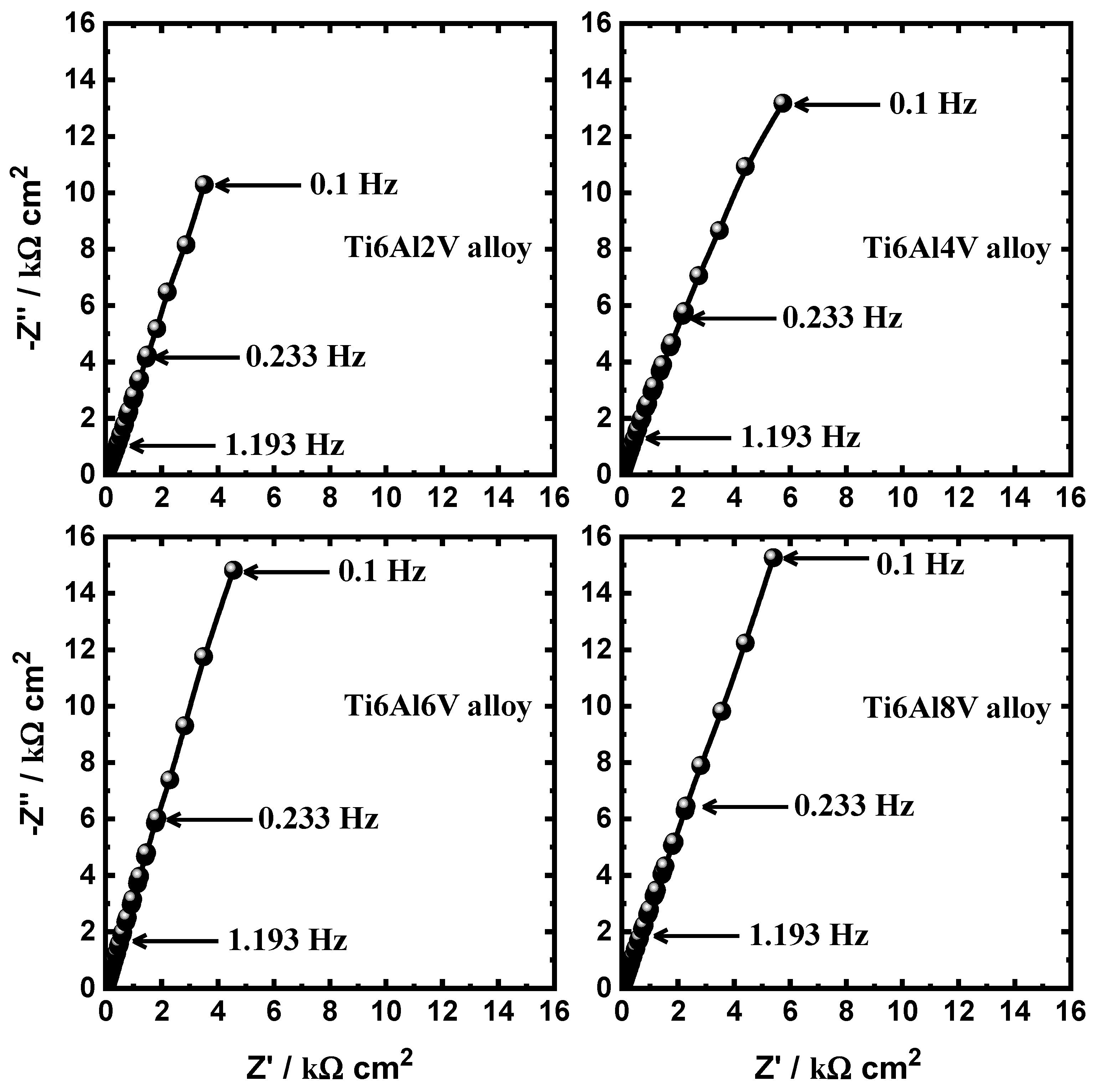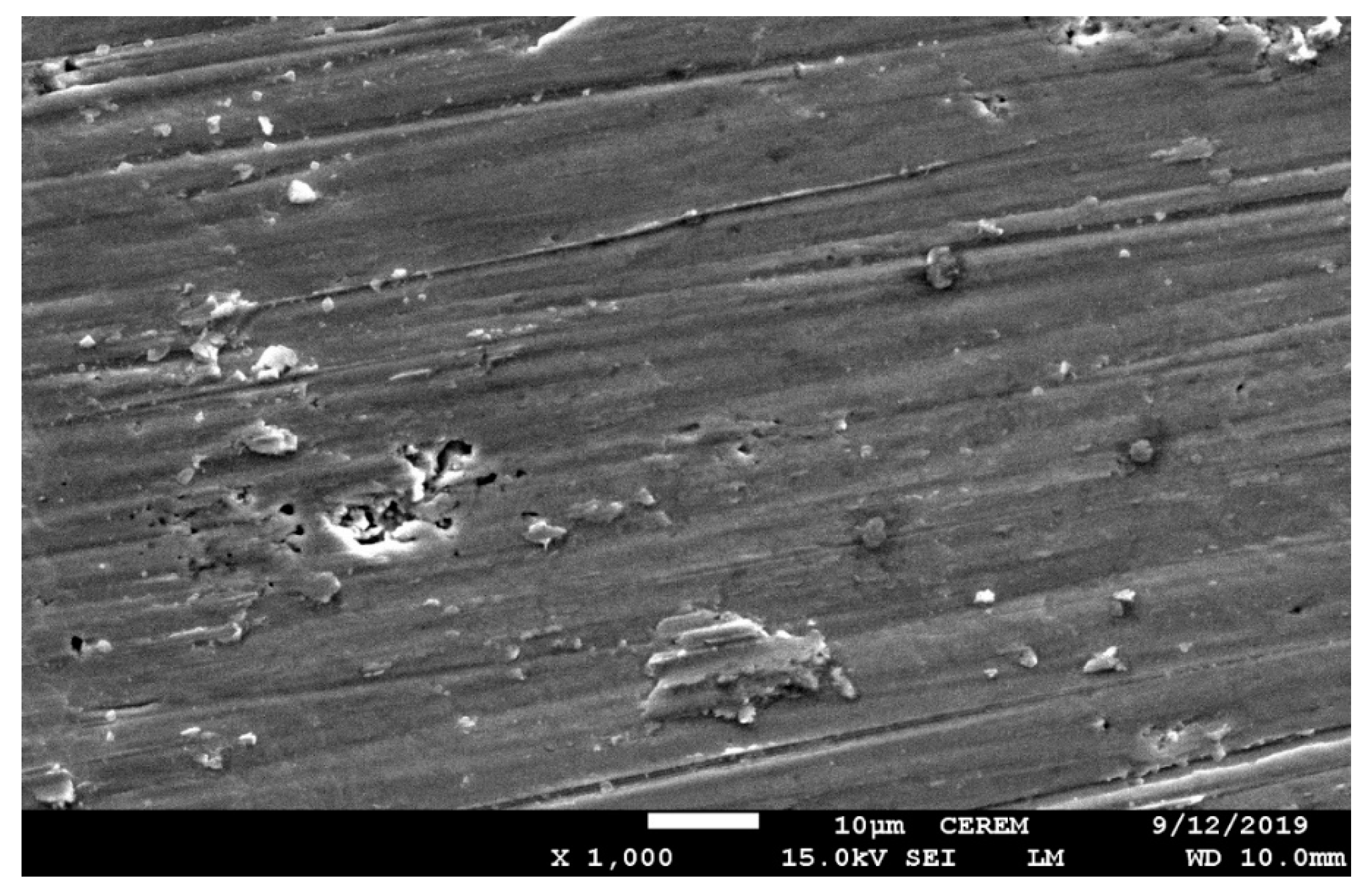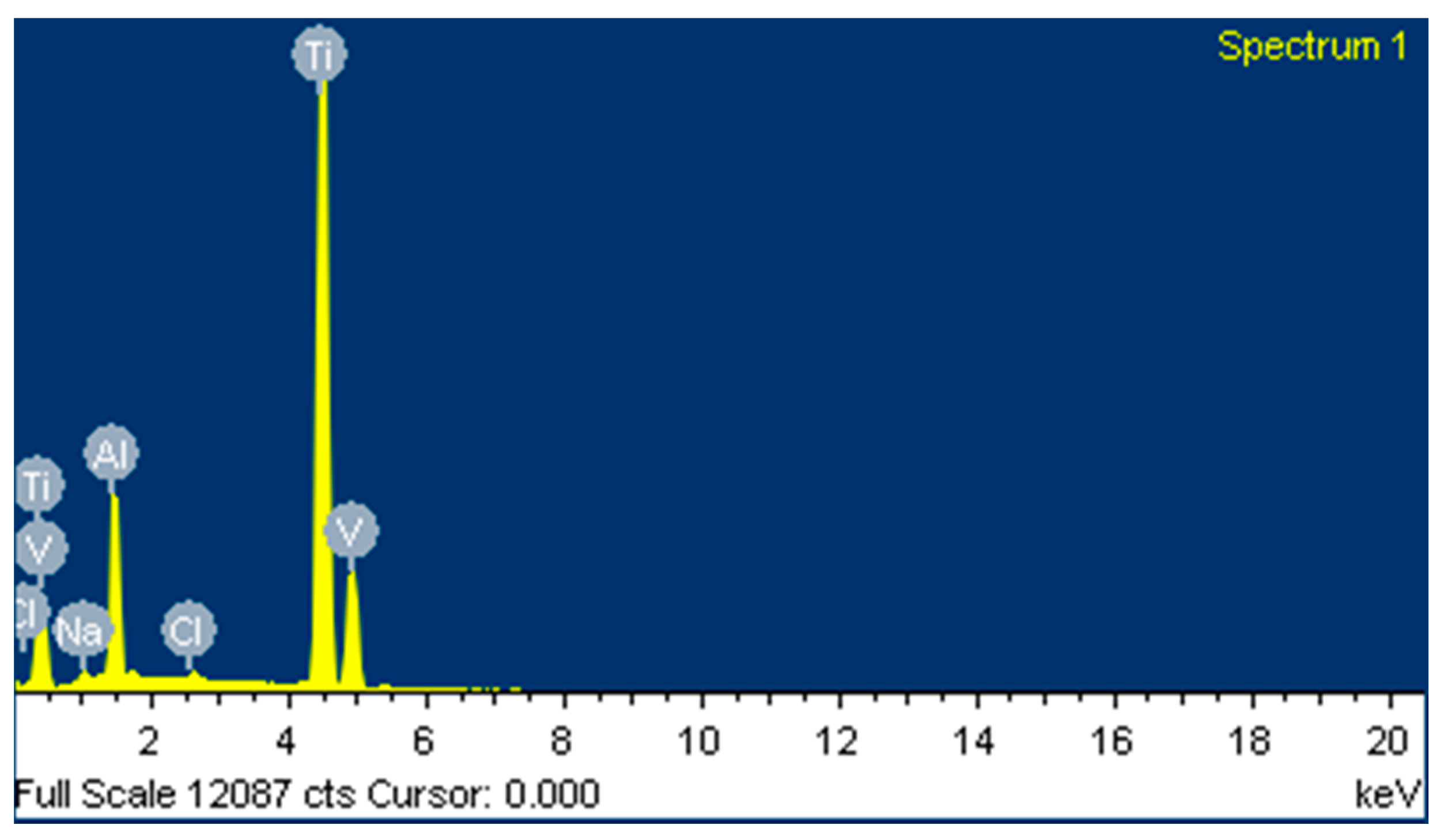Beneficial Effects of Vanadium Additions on the Corrosion of Ti6AlxV Alloys in Chloride Solutions
Abstract
:1. Introduction
2. Experimental Details
2.1. The Fabrication of the Alloys
2.2. Electrochemical and Surface Characterization Techniques
3. Results and Discussion
3.1. EIS Measurements
3.2. Cyclic Potentiodynamic Polarization (CPP) Data
3.3. Potentiostatic Current–Time Measurements
3.4. SEM and EDX Analyses
4. Conclusions
Author Contributions
Funding
Acknowledgments
Conflicts of Interest
References
- Zhang, L.C.; Attar, H. Selective Laser Melting of Titanium Alloys and Titanium Matrix Composites for Biomedical Applications: A Review. Adv. Eng. Mater. 2016, 18, 463–475. [Google Scholar] [CrossRef]
- Zhang, H.; Kou, H.; Yang, J.; Huang, D.; Nan, H.; Li, J. Microstructure evolution and tensile properties of Ti-6.5Al-2Zr-Mo-V alloy processed with thermo hydrogen treatment. Mater. Sci. Eng. A 2014, 619, 274–280. [Google Scholar] [CrossRef]
- Pang, J.; Blackwood, D.J. Corrosion of titanium alloys in high temperature near anaerobic seawater. Corros. Sci. 2016, 105, 17–24. [Google Scholar] [CrossRef]
- Simka, W.; Sadkowski, A.; Warczak, M.; Iwaniak, A.; Dercz, G.; Michalska, J.; MacIej, A. Characterization of passive films formed on titanium during anodic oxidation. Electrochim. Acta 2011, 56, 8962–8968. [Google Scholar] [CrossRef]
- da Silva, L.L.G.; Ueda, M.; Silva, M.M.; Codaro, E.N. Corrosion behavior of Ti-6Al-4V alloy treated by plasma immersion ion implantation process. Surf. Coat. Technol. 2007, 201, 8136–8139. [Google Scholar] [CrossRef]
- Erinosho, M.F.; Akinlabi, E.T.; Pityana, S. Microstructure and Corrosion Behaviour of Laser Metal Deposited Ti6Al4V/Cu Composites in 3.5% Sea Water. Mater. Today Proc. 2015, 2, 1166–1174. [Google Scholar] [CrossRef]
- Ho, W.F. Effect of omega phase on mechanical properties of Ti-Mo alloys for biomedical applications. J. Med. Biol. Eng. 2008, 28, 47–51. [Google Scholar]
- Al Otaibi, A.; Sherif, E.S.M.; Zinelis, S.; Al Jabbari, Y.S. Corrosion behavior of two cp titanium dental implants connected by cobalt chromium metal superstructure in artificial saliva and the influence of immersion time. Int. J. Electrochem. Sci. 2016, 11, 5877–5890. [Google Scholar] [CrossRef]
- Sakaguchi, N.; Mitsuo, N.; Akahori, T.; Saito, T.; Furuta, T. Effects of alloying elements on elastic modulus of Ti-Nb-Ta-Zr system alloy for biomedical applications. Mater. Sci. Forum 2004, 449–452, 1269–1272. [Google Scholar] [CrossRef]
- Koizumi, H.; Takeuchi, Y.; Imai, H.; Kawai, T.; Yoneyama, T. Application of titanium and titanium alloys to fixed dental prostheses. J. Prosthodont. Res. 2019, 63, 266–270. [Google Scholar] [CrossRef]
- He, G.; Hagiwara, M. Ti alloy design strategy for biomedical applications. Mater. Sci. Eng. C 2006, 26, 14–19. [Google Scholar] [CrossRef]
- Hussein, A.H.; Gepreel, M.A.H.; Gouda, M.K.; Hefnawy, A.M.; Kandil, S.H. Biocompatibility of new Ti-Nb-Ta base alloys. Mater. Sci. Eng. C 2016, 61, 574–578. [Google Scholar] [CrossRef]
- Niinomi, M. Recent metallic materials for biomedical applications. Metall. Mater. Trans. A 2002, 33, 477. [Google Scholar] [CrossRef]
- Bangera, M.; D’Costa, V. Titanium and its alloys: properties and applications for use as an oral biomaterial: a review. J. Res. Dent. 2015, 3, 592–599. [Google Scholar] [CrossRef] [Green Version]
- Yu, S.Y.; Scully, J.R. Corrosion and Passivity of Ti-13% Nb-13% Zr in Comparison to Other Biomedical Implant Alloys. Corros. Eng. 1997, 15, 965–976. [Google Scholar] [CrossRef]
- Hrabe, N.; Quinn, T. Effects of processing on microstructure and mechanical properties of a titanium alloy (Ti-6Al-4V) fabricated using electron beam melting (EBM), part 1: Distance from build plate and part size. Mater. Sci. Eng. A 2013, 573, 264–270. [Google Scholar] [CrossRef]
- Hrabe, N.; Quinn, T. Effects of processing on microstructure and mechanical properties of a titanium alloy (Ti-6Al-4V) fabricated using electron beam melting (EBM), Part 2: Energy input, orientation, and location. Mater. Sci. Eng. A 2013, 573, 271–277. [Google Scholar] [CrossRef]
- Khalil, K.A.; Sherif, E.S.M.; Nabawy, A.M.; Abdo, H.S.; Marzouk, W.W.; Alharbi, H.F. Titanium carbide nanofibers-reinforced aluminum compacts, a new strategy to enhance mechanical properties. Materials (Basel) 2016, 9, 399. [Google Scholar] [CrossRef]
- Ahn, H.; Lee, D.; Lee, K.M.; Lee, K.; Baek, D.; Park, S.W. Oxidation behavior and corrosion resistance of Ti-10Ta-10Nb alloy. Surf. Coat. Technol. 2008, 202, 5784–5789. [Google Scholar] [CrossRef]
- Narayanan, R.; Seshadri, S.K. Point defect model and corrosion of anodic oxide coatings on Ti-6Al-4V. Corros. Sci. 2008, 50, 1521–1529. [Google Scholar] [CrossRef]
- Martins Júnior, J.R.S.; Matos, A.A.; Oliveira, R.C.; Buzalaf, M.A.R.; Costa, I.; Rocha, L.A.; Grandini, C.R. Preparation and characterization of alloys of the Ti–15Mo–Nb system for biomedical applications. J. Biomed. Mater. Res. B Appl. Biomater. 2018, 106, 639–648. [Google Scholar] [CrossRef] [PubMed]
- Ohkubo, C.; Hanatani, S.; Hosoi, T. Present status of titanium removable dentures—A review of the literature. J. Oral Rehabil. 2008, 35, 706–714. [Google Scholar] [CrossRef] [PubMed]
- Afzali, P.; Ghomashchi, R.; Oskouei, R.H. On the corrosion Behaviour of low modulus titanium alloys for medical implant applications: A review. Metals 2019, 9, 878. [Google Scholar] [CrossRef] [Green Version]
- Mogoda, A.S.; Ahmad, Y.H.; Badawy, W.A. Corrosion behaviour of Ti-6Al-4V alloy in concentrated hydrochloric and sulphuric acids. J. Appl. Electrochem. 2004, 34, 873–878. [Google Scholar] [CrossRef]
- Amerio, O.N.; Rosenberger, M.R.; Favilla, P.C.; Alterach, M.A.; Schvezov, C.E. Prótesis Valvular Cardíaca Trivalva Asociada a Última Generación de Materiales Hemo-Biocompatibles. Rev. Argentina Cirugía Cardiovasc. 2006, 4, 65–76. [Google Scholar]
- El-Bagoury, N.; Ahmed, S.I.; Ahmed Abu Ali, O.; El-Hadad, S.; Fallatah, A.M.; Mersal, G.A.M.; Ibrahim, M.M.; Wysocka, J.; Ryl, J.; Boukherroub, R.; et al. The Influence of Microstructure on the Passive Layer Chemistry and Corrosion Resistance for Some Titanium-Based Alloys. Materials 2019, 12, 1233. [Google Scholar] [CrossRef] [Green Version]
- Geetha, M.; Singh, A.K.; Asokamani, R.; Gogia, A.K. Ti based biomaterials, the ultimate choice for orthopaedic implants—A review. Prog. Mater. Sci. 2009, 54, 397–425. [Google Scholar] [CrossRef]
- McKay, P.; Mitton, D.B. An Electrochemical Investigation of Localized Corrosion on Titanium in Chloride Environments. Corrosion 1985, 41, 52–62. [Google Scholar] [CrossRef]
- Liu, X.; Chu, P.K.; Ding, C. Surface modification of titanium, titanium alloys, and related materials for biomedical applications. Mater. Sci. Eng. R Rep. 2004, 47, 49–121. [Google Scholar] [CrossRef] [Green Version]
- Oh, K.T.; Kim, K.N. Electrochemical properties of suprastructures galvanically coupled to a titanium implant. J. Biomed. Mater. Res. B Appl. Biomater. 2004, 70B, 318–331. [Google Scholar] [CrossRef]
- Chapala, P.; Sunil Kumar, P.; Joardar, J.; Bhandari, V.; Acharyya, S.G. Effect of alloying elements on the microstructure, coefficient of friction, in-vitro corrosion and antibacterial nature of selected Ti-Nb alloys. Appl. Surf. Sci. 2019, 469, 617–623. [Google Scholar] [CrossRef]
- Rack, H.J.; Qazi, J.I. Titanium alloys for biomedical applications. Mater. Sci. Eng. C 2006, 26, 1269–1277. [Google Scholar] [CrossRef]
- Long, M.; Rack, H.J. Titanium alloys in total joint replacement - A materials science perspective. Biomaterials 1998, 19, 1621–1639. [Google Scholar] [CrossRef]
- Li, Y.; Qu, L.; Wang, F. The electrochemical corrosion behavior of TiN and (Ti,Al)N coatings in acid and salt solution. Corros. Sci. 2003, 45, 1367–1381. [Google Scholar] [CrossRef]
- Sherif, E.S.M.; Abdo, H.S.; Latief, F.H.; Alharthi, N.H.; Zein El Abedin, S. Fabrication of Ti–Al–Cu new alloys by inductive sintering, characterization, and corrosion evaluation. J. Mater. Res. Technol. 2019, 8, 4302–4311. [Google Scholar] [CrossRef]
- Sherif, E.S.M.; Latief, F.H.; Abdo, H.S.; Alharthi, N.H. Electrochemical and Spectroscopic Study on the Corrosion of Ti–5Al and Ti–5Al–5Cu in Chloride Solutions. Met. Mater. Int. 2019, 25, 1511–1520. [Google Scholar] [CrossRef]
- Diamanti, M.V.; Bolzoni, F.; Ormellese, M.; Pérez-Rosales, E.A.; Pedeferri, M.P. Characterisation of titanium oxide films by potentiodynamic polarisation and electrochemical impedance spectroscopy. Corros. Eng. Sci. Technol. 2010, 45, 428–434. [Google Scholar] [CrossRef]
- Vera, M.L.; Linardi, E.; Lanzani, L.; Mendez, C.; Schvezov, C.E.; Ares, A.E. Corrosion resistance of titanium dioxide anodic coatings on Ti-6Al-4V. Mater. Corros. 2015, 66, 1140–1149. [Google Scholar] [CrossRef]
- Zhang, Z.; Chen, S.; Li, Y.; Li, S.; Wang, L. A study of the inhibition of iron corrosion by imidazole and its derivatives self-assembled films. Corros. Sci. 2009, 51, 291–300. [Google Scholar] [CrossRef]
- Orazem, M.E.; Tribollet, B. Electrochemical Impedance Spectroscopy; John Wiley & Sons: Hoboken, NJ, USA, 2008; ISBN 9780470041406. [Google Scholar]
- Alharthi, N.; Sherif, E.S.M.; Abdo, H.S.; El Abedin, S.Z. Effect of Nickel Content on the Corrosion Resistance of Iron-Nickel Alloys in Concentrated Hydrochloric Acid Pickling Solutions. Adv. Mater. Sci. Eng. 2017, 2017, 1–8. [Google Scholar] [CrossRef] [Green Version]
- Sherif, E.S.M. Effects of exposure time on the anodic dissolution of Monel-400 in aerated stagnant sodium chloride solutions. J. Solid State Electrochem. 2012, 16, 891–899. [Google Scholar] [CrossRef]
- Badawy, W.A.; Al-Kharafi, F.M.; El-Azab, A.S. Electrochemical behaviour and corrosion inhibition of Al, Al-6061 and Al-Cu in neutral aqueous solutions. Corros. Sci. 1999, 41, 709–727. [Google Scholar] [CrossRef]
- Mazhar, A.A.; Badawy, W.A.; Abou-Romia, M.M. Impedance studies of corrosion resistance of aluminium in chloride media. Surf. Coatings Technol. 1986, 29, 335–345. [Google Scholar] [CrossRef]
- Sherif, E.M.; Park, S.M. Effects of 1,4-naphthoquinone on aluminum corrosion in 0.50 M sodium chloride solutions. Electrochim. Acta 2006, 51, 1313–1321. [Google Scholar] [CrossRef]
- Tomcsányi, L.; Varga, K.; Bartik, I.; Horányi, H.; Maleczki, E. Electrochemical study of the pitting corrosion of aluminium and its alloys-II. Study of the interaction of chloride ions with a passive film on aluminium and initiation of pitting corrosion. Electrochim. Acta 1989, 34, 855–859. [Google Scholar] [CrossRef]
- Rinner, M.; Gerlach, J.; Ensinger, W. Formation of titanium oxide films on titanium and Ti6A14V by O2-plasma immersion ion implantation. Surf. Coatings Technol. 2000, 132, 111–116. [Google Scholar] [CrossRef]
- Butt, A.; Hamlekhan, A.; Patel, S.; Royhman, D.; Sukotjo, C.; Mathew, M.T.; Shokuhfar, T.; Takoudis, C. A novel investigation of the formation of titanium oxide nanotubes on thermally formed oxide of Ti-6Al-4V. J. Oral Implantol. 2015, 41, 523–531. [Google Scholar] [CrossRef]
- Wall, F.D.; Martinez, M.A.; Vandenavyle, J.J. Relationship between induction time for pitting and pitting potential for high-purity aluminum. J. Electrochem. Soc. 2004, 151, 354–358. [Google Scholar] [CrossRef]
- Diggle, J.W.; Downie, T.C.; Goulding, C.W. The dissolution of porous oxide films on aluminium. Electrochim. Acta 1970, 15, 1079–1093. [Google Scholar] [CrossRef]














| Alloy | Impedance Data | |||||
|---|---|---|---|---|---|---|
| RS/Ω cm2 | Q | RP1/Ω cm2 | Cdl/F cm−2 | RP2/Ω cm2 | ||
| YQ/S*s^n | n | |||||
| Ti6Al2V (1 h) | 17.83 | 0.000108 | 0.80 | 555 | 0.000181 | 2267 |
| Ti6Al4V (1 h) | 19.91 | 0.000112 | 0.73 | 609 | 0.000180 | 5497 |
| Ti6Al6V (1 h) | 23.19 | 0.000123 | 0.80 | 764 | 0.000221 | 8232 |
| Ti6Al8V (1 h) | 25.52 | 0.000141 | 0.72 | 846 | 0.000170 | 10,325 |
| Ti6Al2V (24 h) | 19.34 | 0.000837 | 0.75 | 803 | 0.000746 | 4361 |
| Ti6Al4V (24 h) | 21.07 | 0.000678 | 0.78 | 981 | 0.000190 | 6185 |
| Ti6Al6V (24 h) | 22.65 | 0.000884 | 0.74 | 1079 | 0.000121 | 7237 |
| Ti6Al8V (24 h) | 23.93 | 0.000124 | 0.77 | 1303 | 0.000889 | 8537 |
| Ti6Al2V (48 h) | 23.53 | 0.000111 | 0.71 | 3377 | 0.000477 | 7634 |
| Ti6Al4V (48 h) | 24.58 | 0.000126 | 0.77 | 4203 | 0.000114 | 8035 |
| Ti6Al6V (48 h) | 25.61 | 0.000142 | 0.74 | 4290 | 0.000135 | 9150 |
| Ti6Al6V (48 h) | 26.52 | 0.000133 | 0.75 | 4334 | 0.000152 | 9847 |
| Alloy | Parameter | |||||
|---|---|---|---|---|---|---|
| βc/mV/dec−1 | ECorr/mV | βa/mV·dec−1 | jCorr/µA·cm−2 | Rp/Ω·cm2 | RCorr/mpy | |
| Ti6Al2V (1 h) | 100 | –400 | 90 | 0.25 | 8238 | 0.0218 |
| Ti6Al4V (1 h) | 90 | –380 | 82 | 0.22 | 8480 | 0.0192 |
| Ti6Al6V (1 h) | 85 | –400 | 78 | 0.19 | 9251 | 0.0165 |
| Ti6Al8V (1 h) | 80 | –422 | 75 | 0.15 | 11221 | 0.0131 |
| Ti6Al2V (24 h) | 110 | –447 | 120 | 0.19 | 13133 | 0.0165 |
| Ti6Al4V (24 h) | 105 | –340 | 110 | 0.17 | 13739 | 0.0148 |
| Ti6Al6V (24 h) | 95 | –395 | 90 | 0.15 | 13396 | 0.0131 |
| Ti6Al8V (24 h) | 90 | –375 | 80 | 0.12 | 15345 | 0.0105 |
| Ti6Al2V (48 h) | 120 | –430 | 125 | 0.17 | 15658 | 0.0148 |
| Ti6Al4V (48 h) | 115 | –400 | 125 | 0.15 | 17361 | 0.0131 |
| Ti6Al6V (48 h) | 110 | –470 | 127 | 0.13 | 19714 | 0.0113 |
| Ti6Al6V (48 h) | 110 | –410 | 130 | 0.11 | 23551 | 0.0096 |
© 2020 by the authors. Licensee MDPI, Basel, Switzerland. This article is an open access article distributed under the terms and conditions of the Creative Commons Attribution (CC BY) license (http://creativecommons.org/licenses/by/4.0/).
Share and Cite
Sherif, E.-S.M.; Abdo, H.S.; Alharthi, N.H. Beneficial Effects of Vanadium Additions on the Corrosion of Ti6AlxV Alloys in Chloride Solutions. Metals 2020, 10, 264. https://doi.org/10.3390/met10020264
Sherif E-SM, Abdo HS, Alharthi NH. Beneficial Effects of Vanadium Additions on the Corrosion of Ti6AlxV Alloys in Chloride Solutions. Metals. 2020; 10(2):264. https://doi.org/10.3390/met10020264
Chicago/Turabian StyleSherif, El-Sayed M., Hany S. Abdo, and Nabeel H. Alharthi. 2020. "Beneficial Effects of Vanadium Additions on the Corrosion of Ti6AlxV Alloys in Chloride Solutions" Metals 10, no. 2: 264. https://doi.org/10.3390/met10020264








